Gas boiler repair: overview of typical faults and how to fix them
Gas equipment is the most common option in organizing autonomous heating. It is characterized by reasonable cost, economical fuel consumption and high efficiency. However, any equipment has its own service life and requires restoration over time.
The simplest repair of a gas boiler can be carried out yourself. And any owner simply must cope with the implementation of regular preventive measures on his own. We will tell you how to return the equipment to serviceability and how to extend its service life.
The content of the article:
What can be repaired without gas workers?
There are several main causes of malfunctions. This is the incorrect operation of gas equipment, the presence of an unacceptable microclimate in the boiler room, untimely maintenance of all systems or low-quality components.
When making repairs yourself, be sure to observe safety precautions and strictly follow the instructions. First of all, the user should decide which parts of the gas boiler can and cannot be repaired on their own.
When repairing gas equipment, the main danger is a possible gas leak. Therefore, it is necessary to carry out all manipulations for installation and dismantling of units and parts of the device with caution. Particular attention should be paid to replacing components related to the fuel supply system.
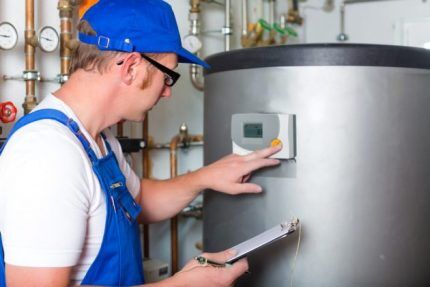
Boiler manufacturers strongly recommend calling gas service employees to correct problems associated with breakdowns of the gas supply system and built-in electronic devices. An inexperienced person will not be able to independently configure, repair and restore the functions of specific automation in a gas boiler.
There are three main elements in the design of a typical gas boiler:
- Gas burner closed/open type;
- Specific security blocks;
- A heat exchange system consisting of one or two internal devices, the number of which is determined by the number of circuits served.
If all the components involved in the operation of the boiler are classified according to their functional purpose, then they can be divided into the following groups: control system devices, hydraulic system devices, burner and gas supply unit, smoke exhaust, boiler operation control devices, multi-level safety systems.
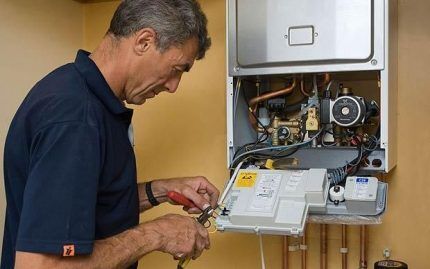
Most of the listed elements cannot be changed or repaired yourself. In case of tampering with the boiler design, its owner loses the right to restore operability at the expense of the manufacturer during the warranty period.But what and how do the craftsmen from the organization with which the contract is concluded repair? service contract unit and gas supply, you need to know.
However, the owner of gas equipment, seeking to extend its service life, can independently produce:
- Chimney cleaning. It is performed in cases where traction is weakened by mechanical manipulation or using chemicals.
- Checking the tightness of water supply connections, gas supply lines, and heating circuit branches.
- Installation voltage stabilizer.
We warn you once again that all actions that require removing the casing from the boiler must be performed by a gas service representative.
However, if the guarantee is not important to you, then you can do it yourself:
- Manual external cleaning and internal flushing of the heat exchanger/heat exchangers. They are easy to dismantle, carry out the necessary procedures, and then install them back. In this case, it is effective to use homemade water solutions of citric acid (100g/1l) or suitable household chemicals that can dissolve calcium deposits.
- Supercharger fan maintenance. Replace the fuse or the fan itself, check the electrical circuit connected to it, and lubricate the bearings with technical fluid.
- Cleaning the injectors. Clogged nozzles cause a weak burner flame. They need to be periodically cleaned to remove any deposits with fine sandpaper and dirt removed with a rag containing household chemicals.
- Adjusting the pressure in the system.
- Finding a problem due to which the boiler does not turn on.
In order to decide how and how to repair a gas boiler, you need to visually inspect it and, if necessary, carry out a series of diagnostic procedures.Self-repair is possible in cases where the manufacturer’s warranty has already expired.
If you smell gas, you should immediately forget about manual intervention. It is necessary to turn off the gas supply, immediately carry out burst ventilation and call an emergency. The rules for operating gas equipment are set out in detail in next article, the contents of which we strongly advise you to familiarize yourself with.
Methods for self-diagnosis of faults
Often the user is in a situation where he is not sure what exactly is broken in the gas boiler. In such cases, there is no need to rush to remove and repair anything. It's risky and dangerous. Before work, you should diagnose the equipment and identify the exact causes of malfunctions.
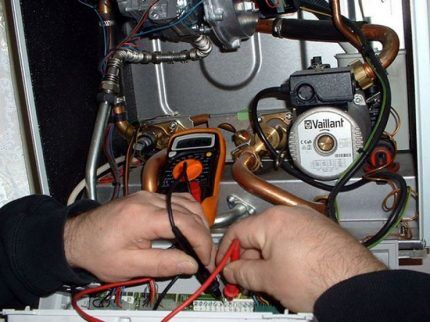
Modern gas boilers are equipped various sensors, which reflect a number of important functional indicators of the unit. They monitor changes in temperature, pressure and other parameters. In the event of a malfunction, modern boiler models provide automatic shutdown of the device.
The source of the breakdown is identified by the consequences it causes. For example, you can visually see fumes, leaks, and sparks. You can smell a gas leak or short circuit by smell. From the changed sound of the gas boiler, it becomes clear that the unit has malfunctioned.
The instructions included with the purchase of the device describe the most common faults in the boiler model being purchased and how to detect, diagnose, and eliminate them. It also indicates what a specific error code and flashing lights on the dashboard.
So the light can blink in different modes: fast or slow. Or burn constantly. The color of the light bulb can be red, green or yellow.
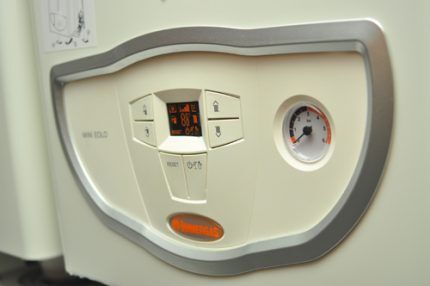
You should not throw away the instructions from the device, as they may be useful to the gas technician you called to fix the problem. It indicates the characteristic features of the gas boiler model, the dimensions and location of components and parts.
Basic malfunctions and their elimination
After carrying out diagnostic procedures and identifying a specific problem, you need to begin solving it. To do this, you will need some tools and components depending on the situation. Most problems can be easily fixed with a tool that is always at hand.
Before starting work, it is important to disconnect the gas boiler from the electrical network. You also need to shut off the gas supply by turning off the gas tap. Even in cases where repair procedures do not affect parts in contact with gas, the fuel supply must be turned off in accordance with safety regulations.
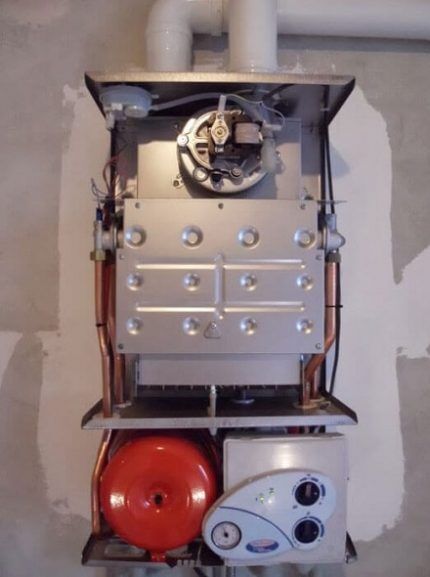
In some cases, it is not possible to estimate approximately the duration of the required repair work. If in such a situation the temperature outside is below zero, then a significant decrease in the temperature in the room is possible. And therefore, the water in the system will freeze.
To prevent ice plugs from forming in the boiler coils, the anti-icing system is never turned off for long periods of time. For example, if the boiler is not used for one or two days, all volatile devices are turned off, except for this function. It is possible to completely disconnect it from the power supply only if the unit is preserved for a long period.
Also, before you begin repairing the boiler and dismantling its internal components, you need to make sure that the working surface of the device has an acceptable temperature. During operation, the casing and appliances of the boiler heat up significantly, and contact with some parts can lead to burns.
Gas boiler does not turn on
Sometimes, when you try to turn on the boiler, you discover that the device simply refuses to work. First of all, you should make sure that the device is connected to the electrical network. Then you need to check whether the switch in the distribution machine is turned on.
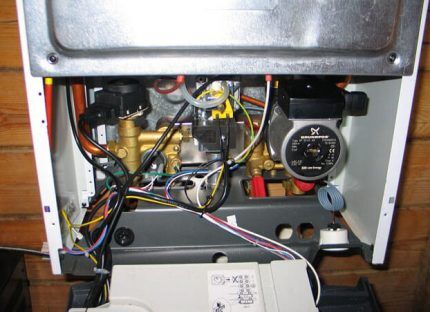
If it turns out that the device is connected to a working outlet, but still does not start, then you need to disconnect the boiler from the network and carefully remove its protective casing. It is necessary to carefully inspect the internal elements of the boiler for signs of a short circuit. Such signs include the presence of a burning smell and soot on the internal elements.
If there are no signs of a short circuit, then you need to inspect the fuse and the electronic board. If a blown fuse is detected, you need to install a new one, turn on the boiler and check its operation. Sometimes after replacement the new fuse immediately burns out. This usually indicates that there is a serious problem inside the boiler or a problem with the wiring.
A common problem with electronic boards is that they get wet. It is better to dry it with a regular home hairdryer, then leave it for a couple of days until the moisture has completely evaporated.
Electrical wiring must be checked for correct connection and wiring. You need to make sure there are no exposed wires or short circuits.
If it is found that the fuse is OK, then you need to inspect the varistor. This device protects the boiler from voltage surges. Perhaps there was a serious voltage surge earlier and the varistor exploded. Only a small part of it may remain. To solve this problem, you will need to resolder the varistor using a blowtorch and the required material.

In cases where the boiler is accurately connected to the electrical network, and the fuse and varistor are in perfect order and after inspection it was not possible to find any visible causes of starting problems, you should call a gas boiler repair specialist. Most likely there is a serious internal problem that will be difficult to fix at home.
A number of models of gas boilers that provide display error code on the dashboard, do not turn on and do not display an error code at the same time. This problem often manifests itself when the circuit of a temperature sensor installed in a room or outside is broken.
It is necessary to inspect the room sensor; perhaps it is unplugged or its batteries are dead. Then you need to replace the batteries or plug the plug into the socket. If the boiler panel does not show the temperature, then most likely there is a problem with the thermostat and it is advisable to start looking for the problem with it.
Problems with filter and pump
The boiler may not operate properly due to a clogged cold water filter. To clean it, you need to turn off the water supply and remove the filter mesh. Rinse it under running water or replace it with a new one.
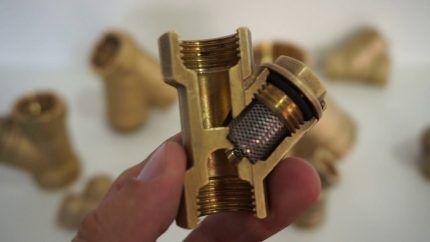
Boiler users may also encounter problems with the pump. The pump stops pumping water when the rotor is broken or air accumulates inside it. First of all, the serviceability of the rotor is checked. To do this, unscrew the nut from the pump and drain the water. Then you need to insert a flat-head screwdriver into the slot and force the axle to rotate. Sometimes the pump jams or sticks.
If it turns out that the pump is broken, you will need to disassemble it yourself and find out the cause of the failure. Having determined which part has broken, you need to order it from a gas equipment store or from a boiler seller. Pump parts are changed at home or in a workshop.
If air has accumulated in the pump, then it is necessary to open the air vent slightly and wait until the excess air comes out.The air vent is closed with a tight-fitting cap. The process of releasing air is accompanied by a characteristic sound.
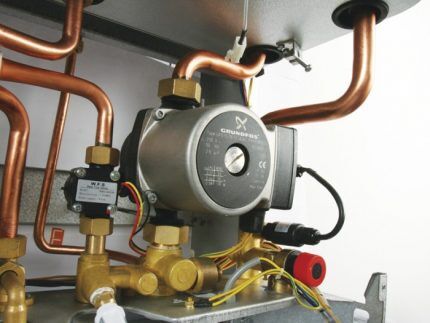
If the pressure gauge needle is in close proximity to the red zone, then you need to turn on the boiler and heat the water in the system. If, with low heating, the pressure rises strongly in the range from 0.7 to 1.5 bar, then you need to carry out a procedure to add air to the expansion tank.
Air is added after the pressure in the system has been reduced to zero. This is done by opening the tap and draining the water. Then, using a pump or compressor, the pressure in the tank is pumped up to 1.3 bar. After this, you need to bring the pressure in the system to 1.5 bar.
Heat exchanger cleaning procedure
The cause of boiler overheating is often faulty automation or a clogged heat exchanger. If gas boiler automation Most likely it will have to be repaired by a service center, but the heat exchanger can be cleared of blockages at home. To do this, you need to turn off the boiler and wait until it cools down. Turn off all taps and remove the cover of the device.
All electrical components and parts, the pump and control devices must be tightly covered with plastic film so that water does not accidentally get on them. By opening the tap or valve of the gas boiler, you need to drain the remaining water from it.
Next, you need to dismantle the burner block with the manifold, remove the fan from its seat, disconnecting the fasteners securing it to the combustion chamber. After which the return pipe is disconnected from the heat exchanger.

To remove the heat exchanger, you must first disconnect the overheating sensor, then remove the combustion chamber. To do this, first unscrew three self-tapping screws, after which the camera along with the cap is pulled towards itself. After which the cap is detached from the chamber and the heat exchanger is disconnected.
The heat exchanger itself is first mechanically cleaned using a brush and emery cloth. Then you need to hold the part in a 10% solution of citric acid or household chemicals that dissolves mineral deposits. Soaking in the solution should run for about 10-15 minutes.
Next, the solution is poured into the internal pipeline and kept there for a period of similar length. Afterwards everything is drained and washed thoroughly with running water. Reassembly is carried out in the exact reverse order. In order not to forget the sequence, it is recommended to take a photo of each step on your phone during dismantling.

It is recommended to clean the heat exchanger every one and a half to two years.
Solving the problem of poor traction
Boilers with an open combustion chamber sometimes lose draft power. To determine the cause of this malfunction, it is worth looking directly into the combustion chamber. Perhaps it is clogged with soot, soot or decay products. You need to brush and vacuum this part.
Models with a closed combustion chamber are equipped coaxial chimneys, which have the following disadvantages. In the cold winter, drops of water fall from the outer pipe into the inner one, and there the water freezes and turns into an icicle.
Ice in the space between the pipes blocks air access to the gas boiler and, therefore, reduces the supply of fresh air required for combustion. To solve this problem, the street part of the chimney is insulated or holes are drilled in the outer pipe to drain condensate.
There are situations when foreign objects and waste get into the chimney. In such cases, you need to carefully dismantle the pipe and clean it of excess contents. Problems with a gas boiler occur when the coaxial chimney becomes excessively clogged. Soot needs to be cleaned out at certain intervals. Then the boiler will work long and efficiently.
It is worth noting that the accumulation of soot in a gas boiler is a rather rare occurrence. Gas does not emit too much soot when burned. Therefore, the manufacturer usually recommends chimney cleaning every two or three years.

Cleaning the chimney is carried out as follows. It is necessary to turn off the boiler, turn off the gas and water supplies and wait until it cools down. Remove the external protection of the boiler and disconnect it from it chimney pipe. Cleaning can be done mechanically or chemically.
It is convenient to clean the lower part of the chimney pipe directly adjacent to the boiler with a long-handled metal brush and then use a brush. After this, you can use chemical solutions.After cleaning the inside, you need to start cleaning the outer outlet of the pipe.
There are several ways to clean the chimney with your own hands while on the roof. Most often, a special metal brush is used on a rope with a weight attached to it. In this case, the circumference of the cleaning tool must correspond to the circumference of the chimney.
Alternately lowering and raising the mechanism, the pipe walls are cleaned. The soot falls down and needs to be shaken out, removed or vacuumed from the inside of the chimney.
Also clean the chimney can be done using a powerful vacuum cleaner specially designed for similar procedures. This device has pockets for drawing in waste. And the hose is long enough to clean the entire chimney.
In special cases, it is worth calling a chimney sweep who has a vacuum unit designed for cleaning chimneys. This expensive device will completely clean the chimney of contaminants without damaging the system.

If you do not solve the problem of weak traction in a timely manner, you may encounter a number of negative consequences:
- Carbon monoxide entering the premises and causing harm to the health of residents;
- Soot accumulations increase the risk of fire;
- Due to carbon deposits on the boiler walls, heat loss and gas consumption increase.
Possible problems indicate that it is necessary to regularly carry out preventive cleaning of the gas device.
Replacing components and eliminating leaks
If leaks and water leaks are detected at the gas boiler connection points, the water supply should be shut off. Then, using a wrench, you need to unscrew the connection, remove the remaining tow and check the threads for damage. After which you need to apply a new layer of tow or FUM tape and screw the pipes tightly.
If, as a result of the inspection, it is discovered that the water pipe is damaged, then you need to replace it yourself or call a plumber.
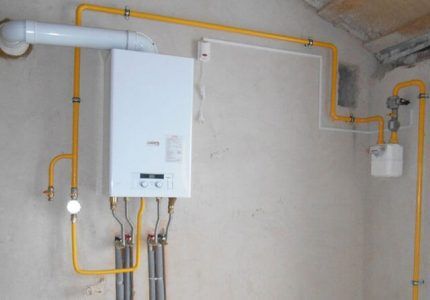
If you detect the smell of gas in the air, turn off the lights and all sources of fire. Open the window and ventilate the room. You can check the location of the leak using a soap solution. After applying it, a soap bubble appears on the pipe. Gas leaks are eliminated in the same way as on a water pipe.
Sometimes after diagnostics it turns out that it is necessary to replace the burner in a gas boiler. You can replace the burner yourself, but you should install exactly the same burner model. It is necessary to disconnect all communications, and when dismantling, be sure to remember the correct location of all elements connected to the burner.
If the boiler refuses to maintain the set temperature, then a broken sensor is usually to blame. Temperature sensors can be surface-mounted or submersible. Overlays are easily mounted on pipes and replaced without difficulty. When installing an immersion sensor, you need to drain the water from the boiler and, after installing the sensor, seal the thread.
In order to maximize the safety of your own space and eliminate the possibility of excess toxins due to the operation of gas equipment, it is recommended to use carbon monoxide sensor. The principle of its operation, selection and installation rules are described in the article we recommend.
Conclusions and useful video on the topic
How to flush the heat exchanger of a gas boiler:
Detecting and correcting gas boiler faults:
Gas boilers are high-tech and safe devices. Like all equipment, they have their own expiration date. If timely maintenance is carried out, the boiler will last a long time. If the boiler begins to malfunction or perform poorly, it is necessary to immediately inspect and diagnose it and identify the cause of the malfunction.
There are a number of common boiler faults. Sometimes the unit simply refuses to turn on or its performance deteriorates due to the coarse filter being too dirty. Users also face the problem of contamination of the heat exchanger and chimney. When carrying out repair work, safety precautions must always be observed.
Would you like to share your own experience in restoring the functionality of a gas boiler? Do you have useful information on a topic that is worth sharing with site visitors? Please leave comments in the block form below, post photos, ask questions.




After purchasing an apartment in which a seemingly expensive Kentatsu boiler was installed, problems immediately began with the previously mentioned gas unit - either the safety automatic system was triggered (as it later turned out there was some kind of malfunction), or the fuse was constantly on when starting the boiler.
And finally, when the boiler did not start at all, and repairs, according to experts, would have cost at least 17 thousand, I decided to buy a new and less finicky (but safe) unit. After consulting with several specialists, they advised me to WARM AUROS. Now I don't know any problems. Our domestic St. Petersburg production. Fits perfectly into the place of the previous awkward wall-mounted boiler, which had worn out all its brains.